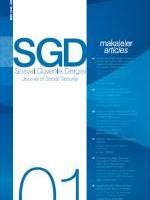Finansal Kuznets Eğrisi Hipotezi: G-7 Ülkeleri Örneği
Finansal Kuznets Eğrisi, G-7 ekonomileri, dinamik en küçük kareler, ARDL
___
- Baiardia, Donatella ve Claudio Morana (2016), “The Financial Kuznets Curve: Evidence for the Euro Area”, Journal of Empirical Finance, Cilt 39, 265–269.
- Batuo, Michael Enowbi; Guidi, Francesco ve Kupukile Mlambo (2012), Financial Development and Income Inequality: Evidence from African Countries, African Development Bank.
- Esteve, Vicente ve Jose L. MartinezZahonero (2007), “Testing the Long-Run Relationship between Health Expenditures and GDP in the Presence of Structural Change: the Case of Spain”, Applied Economic Letters, Cilt 14, 271–276.
- Greenwood, Jeremy ve Boyan Jovanovich (1990), “Financial Development, Growth and the Distribution of Income”, Journal of Political Economy, Cilt 98, 1076–1107.
- Jauch, Sebastian ve Sebastian Watzka (2016), “Financial Development and Income Inequality: A Panel Data Approach”, Empirical Economics, Cilt 51, 291–314.
- Kim, Dong-Hyeon ve Shu-Chin Lin (2011), “Nonlinearity in the Financial Development and Income Inequality Nexus”, Journal of Comparative Economics, Cilt 39, 310–325.
- Kuznets, Simon (1955), “Economic Growth and Income Inequality”, The American Economic Review, Cilt 45, 1–28.
- Narayan, Paresh Kumar; Seema Narayan (2004), “Estimating Income and Price Elasticities of Imports for Fiji in a Cointegration Framework”, Economic Modeling, Cilt 22, 423–438.
- Ng, Serena ve Pierre Perron (2001), “Lag Length Selection and the Construction of Unit Root Tests with Good Size and Power”, Econometrica, Cilt 69, 1529– 1554.
- Nikoloski, Zlatko (2013), “Financial Sector Development and Inequality: Is there any Financial Kuznets Curve?”, Journal of International Development, Cilt 25, 897–911.
- Pesaran M. Hashem; Yongcheol, Shin, ve Richard J. Smith (2001), “Bounds Testing Approaches to the Analysis of Level Relationships”, Journal of Applied Econometrics, Cilt 16, 289–326.
- Rehman, Hafeez Ur; Khan, Sajawal ve Ahmed Imtiaz (2008), “Income Distribution, Growth and Financial Development: A Cross Countries Analysis”, Pakistan Economic and Social Review, Cilt 46, 1–16.
- Sevüktekin, Mustafa ve Mehmet Nargeleçekenler (2007), Ekonometrik Zaman Serileri Analizi, Ankara, Nobel Yayın.
- Shahbaz, Muhammad ve Faridul Islam (2011), “Financial Development and Income Inequality in Pakistan: An Application of ARDL Approach”, Journal of Economic Development, Cilt 36, 35–58.
- Shahbaz, Muhammad; Loganathan, Nanthakumar Tiwari, Aviral Kumar ve Reza Sherafatian-Jahromi (2015), “Financial Development and Income Inequality: Is There Any Financial Kuznets Curve in Iran?”, Social Indicators Research, Cilt 124, 357–382.Sosyal Güvenlik Dergisi • Journal of Social Security • 2017/2 156
- Shin, Yongcheol (1994), “A ResidualBased Test of the Null of Cointegration Against the Alternative of no Cointegration”, Econometric Theory, Cilt 10, 91–115.
- Stock, James H. ve Mark W. Watson (1993), “A Simple Estimator of Cointegration Vectors in Higher Order Integrated Systems”, Econometrica, Cilt 61, 783–820.
- Tan, Hui-Boon ve Siong-Hook Law (2012), “Nonlinear Dynamics of the Finance-Inequality Nexus in Developing Countries”, Journal of Economic Inequality, Cilt 9, 1–13.
- ISSN: 2146-4839
- Yayın Aralığı: Yılda 2 Sayı
- Yayıncı: T. C. Sosyal Güvenlik Kurumu
İşyerlerinde ve İşletmelerde İş Sağlığı ve Güvenliği Hiyerarşisi
İşsizlik Oranı Üzerindeki Şoklar Gerçekten Kalıcı mı: Türkiye Ekonomisi Üzerine Bir Analiz
Türker Topalhan, Ömer Tanju Durusoy, Zeynel Abidin Özdemir
İşçi Sigortaları Kurumunun Kuruluşu
Ülke Örnekleri ile Türkiye’de Yarı Zamanlı Çalışmanın Görünümü
Kadınların İş-Aile Yaşamı Çatışmasını Engellemeye Yönelik Hukuki Düzenlemeler
Hastanelerde Maliyet Analizi: Kamu Hastanesi Örneği
Finansal Kuznets Eğrisi Hipotezi: G-7 Ülkeleri Örneği
